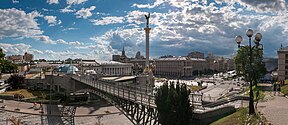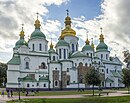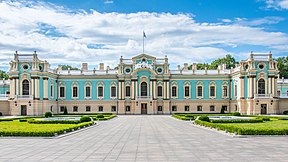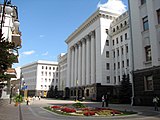Kyiv
Kyiv
Київ (Ukrainian) Kiev | ||
|---|---|---|
|
City council Kyiv City Council | | |
| Districts | ||
| Government | ||
| • UP12 | ||
| Website | kyivcity.gov.ua | |
Kyiv (also spelled Kiev)[a] is the capital and most populous city of Ukraine. It is in north-central Ukraine along the Dnieper River. As of 1 January 2022, its population was 2,952,301,[2] making Kyiv the seventh-most populous city in Europe.[11] Kyiv is an important industrial, scientific, educational, and cultural center in Eastern Europe. It is home to many high-tech industries, higher education institutions, and historical landmarks. The city has an extensive system of public transport and infrastructure, including the Kyiv Metro.
The city's name is said to derive from the name of
The city prospered again during the Russian Empire's
Following
Name
- English: Kyiv (/ˈkiːjɪv/ KEE-yiv,[14] /kiːv/ KEEV[15]) or Kiev (/ˈkiːɛv/ KEE-ev)[16][17]
- Ukrainian: Київ, romanized: Kyiv, pronounced [ˈkɪjiu̯] ⓘ[citation needed]
- Russian: Киев, romanized: Kiyev,[b] pronounced [ˈkʲi(j)ɪf] ⓘ[17]
The traditional etymology, stemming from the
Kyiv is the romanized official Ukrainian name for the city,[20][21] and it is used for legislative and official acts.[22] Kiev is the traditional English name for the city,[20][23][24] but because of its historical derivation from the Russian name, Kiev lost favor with many Western media outlets after the outbreak of the Russo-Ukrainian War in 2014 in conjunction with the KyivNotKiev campaign launched by Ukraine to change the way that international media were spelling the city's name.[25]
History
The first known humans in the region of Kyiv lived there in the late paleolithic period (Stone Age).[26] The population around Kyiv during the Bronze Age formed part of the so-called Trypillian culture, as evidenced by artifacts from that culture found in the area.[27] During the early Iron Age certain tribes settled around Kyiv that practiced land cultivation, husbandry and trading with the Scythians and ancient states of the northern Black Sea coast.[26] Findings of Roman coins of the 2nd to the 4th centuries suggest trade relations with the eastern provinces of the Roman Empire.[26] Notable archaeologists of the area around Kyiv include Vikentiy Khvoyka.
Founding
Scholars continue to debate when the city was founded: The traditional founding date is 482 CE, so the city celebrated
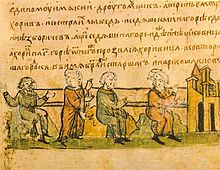
There are several legendary accounts of the origin of the city. One tells of members of a Slavic tribe (
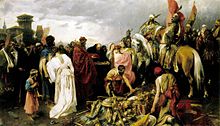
There is little historical evidence pertaining to the period when the city was founded. Scattered
However, according to the 1773 Dictionary of Ancient Geography of Alexander Macbean, that settlement corresponds to the modern city of Chernobyl. Just south of Azagarium, there is another settlement, Amadoca, believed to be the capital of the Amadoci people[32] living in an area between the marshes of Amadoca in the west and the Amadoca mountains in the east.
Another name for Kyiv mentioned in history, the origin of which is not completely clear, is Sambat, which apparently has something to do with the
At least three Arabic-speaking 10th century geographers who traveled the area mention the city of Zānbat as the chief city of the Russes. Among them are ibn Rustah,
The Primary Chronicle states that at some point during the late 9th or early 10th century Askold and Dir, who may have been of Viking or Varangian descent, ruled in Kyiv. They were murdered by
Other historians suggest that
According to the aforementioned scholars the building of the fortress of Kyiv was finished in 840 under the leadership of Keő (Keve), Csák, and Geréb, three brothers, possibly members of the Tarján tribe. The three names appear in the Kyiv Chronicle as Kyi, Shchek, and Khoryv and may be not of Slavic origin, as Russian historians have always struggled to account for their meanings and origins. According to Hungarian historian Viktor Padányi, their names were inserted into the Kyiv Chronicle in the 12th century, and they were identified as old-Russian mythological heroes.[35]
The city of Kyiv stood on the
In March 1169, Grand Prince
These events had a profound effect on the future of the city and on the
In the early 1320s, a Lithuanian army led by Grand Duke

With the 1569
Russian suzerainty
Occupied by Russian troops since the 1654

In 1834, the Russian government established Saint Vladimir University, now called the Taras Shevchenko National University of Kyiv after the Ukrainian poet Taras Shevchenko (1814–1861). (Shevchenko worked as a field researcher and editor for the geography department). The medical faculty of Saint Vladimir University, separated into an independent institution in 1919–1921 during the Soviet period, became the Bogomolets National Medical University in 1995.
During the 18th and 19th centuries, the
Following the gradual loss of Ukraine's autonomy, Kyiv experienced growing

During the
Soviet era
In the
From 1921 to 1991, the city formed part of the
In 1934, Kyiv became the capital of Soviet Ukraine. The city boomed again during the years of Soviet industrialization as its population grew rapidly and many industrial giants were established, some of which exist today.
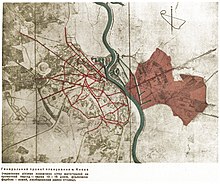
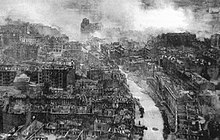
In
Allegedly in response to the actions of the NKVD, the Germans rounded up all the local
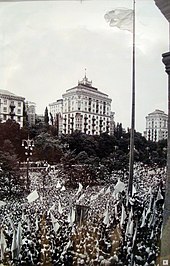
Kyiv recovered economically in the post-war years, becoming once again the third-most important city of the Soviet Union. The catastrophic accident at the Chernobyl Nuclear Power Plant in 1986 occurred only 100 km (62 mi) north of the city. However, the prevailing south wind blew most of the radioactive debris away from Kyiv.
Independence
In the course of the
Environment
Geography
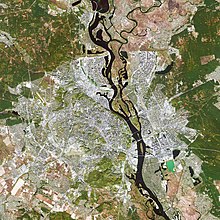
Geographically, Kyiv is on the border of the Polesia woodland ecological zone, a part of the European mixed woods area, and the East European forest steppe biome. However, the city's unique landscape distinguishes it from the surrounding region. Kyiv is completely surrounded by Kyiv Oblast.
Originally on the west bank, today Kyiv is on both sides of the
The northern outskirts of the city border the Polesian Lowland. Kyiv expanded into the Dnieper Lowland on the left bank (to the east) as late as the 20th century. The whole portion of Kyiv on the left bank of the Dnieper is generally referred to as the Left Bank (Лівий берег, Livyi bereh). Significant areas of the left bank Dnieper valley were artificially sand-deposited, and are protected by dams.
Within the city the Dnieper River forms a branching system of
In total, there are 448 bodies of open water within the boundaries of Kyiv, which include the Dnieper itself, its reservoirs, and several small rivers, dozens of lakes and artificially created ponds. They occupy 7949 hectares. Additionally, the city has 16 developed beaches (totalling 140 hectares) and 35 near-water recreational areas (covering more than 1,000 hectares). Many are used for pleasure and recreation, although some of the bodies of water are not suitable for swimming.[59][60]
According to the
Climate
Kyiv has a warm-summer humid continental climate (Köppen Dfb).[62] The warmest months are June, July, and August, with mean temperatures of 13.8 to 24.8 °C (56.8 to 76.6 °F). The coldest are December, January, and February, with mean temperatures of −4.6 to −1.1 °C (23.7 to 30.0 °F). The highest ever temperature recorded in the city was 39.4 °C (102.9 °F) on 30 July 1936.[63][64]
The coldest temperature ever recorded in the city was −32.9 °C (−27.2 °F) on 11 January 1951.[63][64] Snow cover usually lies from mid-November to the end of March, with the frost-free period lasting 180 days on average, but surpassing 200 days in some years.[28]
| Climate data for Kyiv (1991–2020, extremes 1881–present) | |||||||||||||
|---|---|---|---|---|---|---|---|---|---|---|---|---|---|
| Month | Jan | Feb | Mar | Apr | May | Jun | Jul | Aug | Sep | Oct | Nov | Dec | Year |
| Record high °C (°F) | 13.2 (55.8) |
17.3 (63.1) |
22.4 (72.3) |
30.2 (86.4) |
33.6 (92.5) |
35.5 (95.9) |
39.4 (102.9) |
39.3 (102.7) |
35.7 (96.3) |
27.9 (82.2) |
23.2 (73.8) |
15.2 (59.4) |
39.4 (102.9) |
| Mean daily maximum °C (°F) | −0.8 (30.6) |
0.7 (33.3) |
6.5 (43.7) |
15.0 (59.0) |
21.1 (70.0) |
24.6 (76.3) |
26.5 (79.7) |
25.9 (78.6) |
20.0 (68.0) |
12.9 (55.2) |
5.3 (41.5) |
0.5 (32.9) |
13.2 (55.8) |
| Daily mean °C (°F) | −3.2 (26.2) |
−2.3 (27.9) |
2.5 (36.5) |
10.0 (50.0) |
15.8 (60.4) |
19.5 (67.1) |
21.3 (70.3) |
20.5 (68.9) |
14.9 (58.8) |
8.6 (47.5) |
2.6 (36.7) |
−1.8 (28.8) |
9.0 (48.2) |
| Mean daily minimum °C (°F) | −5.5 (22.1) |
−5.0 (23.0) |
−0.8 (30.6) |
5.7 (42.3) |
10.9 (51.6) |
14.8 (58.6) |
16.7 (62.1) |
15.7 (60.3) |
10.6 (51.1) |
5.1 (41.2) |
0.4 (32.7) |
−3.9 (25.0) |
5.4 (41.7) |
| Record low °C (°F) | −31.1 (−24.0) |
−32.2 (−26.0) |
−24.9 (−12.8) |
−10.4 (13.3) |
−2.4 (27.7) |
2.5 (36.5) |
5.8 (42.4) |
3.3 (37.9) |
−2.9 (26.8) |
−17.8 (0.0) |
−21.9 (−7.4) |
−30.0 (−22.0) |
−32.2 (−26.0) |
| Average precipitation mm (inches) | 38 (1.5) |
40 (1.6) |
40 (1.6) |
42 (1.7) |
65 (2.6) |
73 (2.9) |
68 (2.7) |
56 (2.2) |
57 (2.2) |
46 (1.8) |
46 (1.8) |
47 (1.9) |
618 (24.3) |
| Average extreme snow depth cm (inches) | 9 (3.5) |
11 (4.3) |
7 (2.8) |
0 (0) |
0 (0) |
0 (0) |
0 (0) |
0 (0) |
0 (0) |
0 (0) |
2 (0.8) |
5 (2.0) |
11 (4.3) |
| Average rainy days | 8 | 7 | 9 | 13 | 14 | 15 | 14 | 11 | 14 | 12 | 12 | 9 | 138 |
| Average snowy days | 17 | 17 | 10 | 2 | 0.2 | 0 | 0 | 0 | 0.03 | 2 | 9 | 16 | 73 |
| Average relative humidity (%)
|
82.7 | 80.1 | 74.0 | 64.3 | 62.0 | 67.5 | 68.3 | 66.9 | 73.5 | 77.4 | 84.6 | 85.6 | 73.9 |
| Mean monthly sunshine hours | 42 | 64 | 112 | 162 | 257 | 273 | 287 | 252 | 189 | 123 | 51 | 31 | 1,843 |
| Average ultraviolet index | 1 | 1 | 2 | 4 | 6 | 7 | 6 | 6 | 4 | 2 | 1 | 1 | 3 |
| Source 1: Pogoda.ru.net,[65] Central Observatory for Geophysics (extremes),[63][64] World Meteorological Organization (humidity 1981–2010)[66] | |||||||||||||
| Source 2: Danish Meteorological Institute (sun, 1931–1960)[67] and Weather Atlas[68] | |||||||||||||
Legal status, local government and politics
Legal status and local government
The municipality of the city of Kyiv has a
The mayor of Kyiv is
Most key buildings of the national government are along Hrushevskoho Street (vulytsia Mykhaila Hrushevskoho) and Institute Street (vulytsia Instytutska). Hrushevskoho Street is named after the Ukrainian academician, politician, historian, and statesman Mykhailo Hrushevsky, who wrote an academic book titled: "Bar Starostvo: Historical Notes: XV–XVIII" about the history of Bar, Ukraine.[71] That portion of the city is also unofficially known as the government quarter (урядовий квартал).
The city state administration and council is in the Kyiv City council building on Khreshchatyk Street. The oblast state administration and council is in the oblast council building on ploshcha Lesi Ukrainky ("Lesya Ukrainka Square").
-
The seat of the Cabinet of Ministers of Ukraine
-
The presidential administration building
-
The seat of Kyiv City State and City Council on Khreshchatyk Street
Politics
This section needs expansion. You can help by adding to it. (August 2013) |
The growing political and economic role of the city, combined with its international relations, as well as extensive
Subdivisions
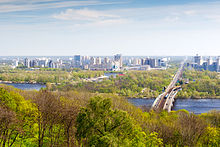
Traditional subdivision
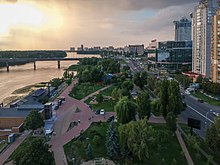
The
Kyiv is further informally divided into historical or territorial neighbourhoods, each housing from about 5,000 to 100,000 inhabitants.
Formal subdivision
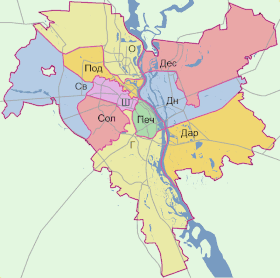
- Г – Holosiivskyi District
- О – Obolonskyi District
- Печ – Pecherskyi District
- Под – Podilskyi District
- Ш – Shevchenkivskyi District
- Св – Sviatoshynskyi District
- Сол – Solomianskyi District
- Дар – Darnytskyi District
- Дес – Desnianskyi District
- Дн – Dniprovskyi District
The first known formal subdivision of Kyiv dates to 1810 when the city was subdivided into 4 parts:
During the Soviet era, as the city was expanding, the number of raions also gradually increased. These newer districts of the city, along with some older areas were then named in honour of prominent communists and socialist-revolutionary figures; however, due to the way in which many communist party members eventually, after a certain period of time, fell out of favour and so were replaced with new, fresher minds, so too did the names of Kyiv's districts change accordingly.
The last district reform took place in 2001 when the number of districts was decreased from 14 to 10.
Under Oleksandr Omelchenko (mayor from 1999 to 2006), there were further plans for the merger of some districts and revision of their boundaries, and the total number of districts had been planned to be decreased from 10 to 7. With the election of the new mayor-elect (Leonid Chernovetskyi) in 2006, these plans were shelved.
Each district has its own locally elected council with jurisdiction over a limited scope of affairs.[78]
Demographics
This section needs to be updated. (February 2023) |
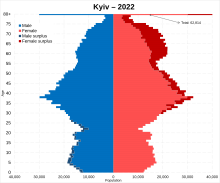
According to the official registration statistics, there were 2,847,200 residents within the city limits of Kyiv in July 2013.[79]
Historical population
| Year | Pop. | ±% |
|---|---|---|
| 10xx | 100,000 | — |
| 1647 | 15,000 | −85.0% |
| 1666 | 10,000 | −33.3% |
| 1763 | 42,000 | +320.0% |
| 1797 | 19,000 | −54.8% |
| 1835 | 36,500 | +92.1% |
| 1845 | 50,000 | +37.0% |
| 1856 | 56,000 | +12.0% |
| 1865 | 71,300 | +27.3% |
| 1874 | 127,500 | +78.8% |
| 1884 | 154,500 | +21.2% |
| 1897 | 247,700 | +60.3% |
| 1905 | 450,000 | +81.7% |
| 1909 | 468,000 | +4.0% |
| 1912 | 442,000 | −5.6% |
| 1914 | 626,300 | +41.7% |
| 1917 | 430,500 | −31.3% |
| 1919 | 544,000 | +26.4% |
| 1922 | 366,000 | −32.7% |
| 1923 | 413,000 | +12.8% |
| 1926 | 513,000 | +24.2% |
| 1930 | 578,000 | +12.7% |
| 1940 | 930,000 | +60.9% |
| 1943 | 180,000 | −80.6% |
| 1956 | 991,000 | +450.6% |
| 1959 | 1,104,300 | +11.4% |
| 1965 | 1,367,200 | +23.8% |
| 1970 | 1,632,000 | +19.4% |
| 1975 | 1,947,000 | +19.3% |
| 1980 | 2,191,500 | +12.6% |
| 1985 | 2,461,000 | +12.3% |
| 1991 | 2,593,400 | +5.4% |
| 1996 | 2,637,900 | +1.7% |
| 2000 | 2,615,300 | −0.9% |
| 2005 | 2,596,400 | −0.7% |
| 2010 | 2,786,518 | +7.3% |
| 2015 | 2,890,432 | +3.7% |
| at 1 January of respective year.[80][81] | ||
According to the
The June 2007 unofficial population estimate based on amount of bakery products sold in the city (thus including temporary visitors and commuters) gave a number of at least 3.5 million people.[83]
Ethnic composition
Kyiv's ethnic composition has shifted greatly over the last centuries. According to the census of March 2, 1874, conducted by the local branch of the Russian Geographical Society, there were 127,205 people living in Kyiv. Of these, 80% spoke "Russian," 11% spoke "Jewish," 6% spoke Polish and 2% spoke German. Of the "Russian" speakers, 39% were recorded as speaking Little Russian (Ukrainian), which meant that Ukrainian speakers accounted for 30% of the city as a whole. Of the remaining "Russian" speakers, however, there were only 10% who spoke Greater Russian (Russian) and 2% who spoke Belarusian. The remaining 49% spoke in "generally Russian speech."[84] According to the official census of 1897, the number of Great Russian speakers rose to 54%; speakers of Little Russian accounted for 22%. Jewish speakers accounted for 12%, Polish 6.7%.[85]
By the September 1917 city-census of Kyiv, conducted by the authorities of the
According to the 2001 census data, more than 130 nationalities and ethnic groups reside within the territory of Kyiv.
A 2015 study by the
Language statistics
Both Ukrainian and Russian are commonly spoken in the city; approximately 75% of Kyiv's population responded "Ukrainian" to the 2001 census question on their native language, roughly 25% responded "Russian".[90] According to a 2006 survey, Ukrainian is used at home by 23% of Kyivans, 52% use Russian, and 24% switch between both.[91] In the 2003 sociological survey, when the question "What language do you use in everyday life?" was asked, 52% said "mostly Russian", 32% "both Russian and Ukrainian in equal measure", 14% "mostly Ukrainian", and 4.3% "exclusively Ukrainian".[92]
According to the census of 1897, of Kyiv's approximately 240,000 people approximately 56% of the population spoke the Russian language, 23% spoke the Ukrainian language, 13% spoke Yiddish, 7% spoke Polish and 1% spoke the Belarusian language.[93]
A 2015 study by the International Republican Institute found that the languages spoken at home in Kyiv were Ukrainian (27%), Russian (32%), and an equal combination of Ukrainian and Russian (40%).[89]
Jews
The Jews of Kyiv are first mentioned in a 10th-century letter. The Jewish population remained relatively small until the nineteenth century.
Jews began returning to Kyiv at the end of the war, but experienced another pogrom in September 1945.
Cityscape
Modern Kyiv is a mix of the old (Kyiv preserved about 70 percent of more than 1,000 buildings built during 1907–1914)
The plans of building massive monuments (of
Ukrainian independence at the turn of the millennium has heralded other changes. Western-style residential complexes, modern
At the United Nations Climate Change Conference 2009, Kyiv was the only Commonwealth of Independent States city to have been inscribed into the TOP30 European Green City Index (placed 30th).[103]
Kyiv's most famous historical architecture complexes are the St. Sophia Cathedral and the Kyiv Pechersk Lavra (Monastery of the Caves), which are recognized by UNESCO as a World Heritage Site. Noteworthy historical architectural landmarks also include the Mariinskyi Palace (designed and constructed from 1745 to 1752, then reconstructed in 1870), several Eastern Orthodox churches such as St. Michael's Cathedral, St. Andrew's, St. Volodymyr's, St. Cyril's, the reconstructed Golden Gate and others.
One of Kyiv's widely recognized modern landmarks is the highly visible giant Mother Ukraine statue made of titanium standing at the National Museum of the History of Ukraine in the Second World War on the Right bank of the Dnieper. Other notable sites is the cylindrical Salut hotel, across from Glory Square and the eternal flame at the World War Two memorial Tomb of the Unknown Soldier, and the House with Chimaeras.
Among Kyiv's best-known monuments are
- Architecture and historically significant sites and monuments in Kyiv
-
Golden Gate
-
Holy Dormition Cathedral
-
St. Sophia Cathedral
-
St. Volodymyr's Cathedral
-
St. Michael's Golden-Domed Monastery
-
St. Nicholas Roman Catholic Cathedral
-
Saint Andrew's Church
-
Mariinskyi Palace
-
"House with Chimaeras"
-
Brodsky Choral Synagogue – Moorish Revival architecture
Culture


Kyiv was the historic cultural centre of the
In September 2023, the UNESCO World Heritage Committee placed the Saint Sophia Cathedral and Kyiv Pechersk Lavra on the List of World Heritage in Danger. According to the committee, although the Ukrainian government has taken action to protect the sites, "optimal conditions are no longer met to fully guarantee the protection of the Outstanding Universal Value of the property and that it is threatened by potential danger due to the war”. The list is protected by the 1972 UNESCO Convention, ratified by both Russia and Ukraine. Inclusion on the list is intended to mobilize urgent international support.[104][105][106]
Kyiv's theatres include the Kyiv Opera House, Ivan Franko National Academic Drama Theater, Lesya Ukrainka National Academic Theater, the Kyiv Puppet Theater, October Palace, National Philharmonic of Ukraine and others. In 1946 Kyiv had four theatres, one opera house and one concert hall,[107] but most tickets then were allocated to "privileged groups".[107]
Other significant cultural centres include the
In 2005, Kyiv hosted the 50th annual Eurovision Song Contest and in 2017 the 62nd annual Eurovision Song Contest.
Numerous songs and paintings were dedicated to the city. Some songs became part of Russian, Ukrainian and Jewish folklore. The most popular songs are "How not to love you, Kyiv of mine?" and "Kyiv Waltz". Renowned Ukrainian composer Oleksandr Bilash wrote an operetta called "Legend of Kyiv".
Attractions
It is said that one can walk from one end of Kyiv to the other in the summertime without leaving the shade of its many trees. Most characteristic are the horse-chestnuts (каштани, kashtany).
Kyiv is known as a green city with
Among the numerous islands, Venetsiiskyi (or Hydropark) is the most developed. It is accessible by metro or by car, and includes an amusement park, swimming beaches, boat rentals, and night clubs. Other major islands include Trukhaniv, Muromets, and Dolobetskyi. The Victory Park (Park Peremohy) near Darnytsia subway station is a popular destination for strollers, joggers, and cyclists. Boating, fishing, and water sports are popular pastimes in Kyiv. The area lakes and rivers freeze over in the winter and ice fishermen are a frequent sight, as are children with their ice skates. However, the peak of summer draws out a greater mass of people to the shores for swimming or sunbathing, with daytime high temperatures sometimes reaching 30 to 34 °C (86 to 93 °F).[citation needed]
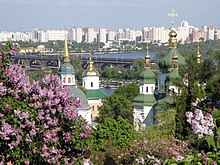
The centre of Kyiv (Maidan Nezalezhnosti and Khreschatyk Street) becomes a large outdoor party place at night during summer months, with thousands of people having a good time in nearby restaurants, clubs and outdoor cafes. The central streets are closed for auto traffic on weekends and holidays. Andriivskyi Descent is one of the best known historic streets and a major tourist attraction in Kyiv. The hill is the site of the Castle of Richard the Lionheart; the baroque-style St Andrew's Church; the home of Kyiv born
A wide variety of farm produce is available in many of Kyiv's farmer markets with the Bessarabskyi Market in the very centre of the city being most famous. Each residential region has its own market, or rynok. Here one will find table after table of individuals hawking everything imaginable: vegetables, fresh and smoked meats, fish, cheese, honey, dairy products such as milk and home-made smetana (sour cream), caviar, cut flowers, housewares, tools and hardware, and clothing. Each of the markets has its own unique mix of products with some markets devoted solely to specific wares such as automobiles, car parts, pets, clothing, flowers, and other things.
At the city's southern outskirts, near the historic Pyrohiv village, there is an outdoor museum officially called the Museum of Folk Architecture and Life of Ukraine. It has an area of 1.5 square kilometres (1 sq mi). This territory houses several "mini-villages" that represent by region the traditional rural architecture of Ukraine.
Kyiv also has numerous recreational attractions like bowling alleys, go-cart tracks, paintball venues, billiard halls and even shooting ranges. The 100-year-old Kyiv Zoo is on 40 hectares and according to CBC "the zoo has 2,600 animals from 328 species".[110]
Museums and galleries
Kyiv is home to some 40 different museums.[111] In 2009 they recorded a total of 4.3 million visits.[111]
The National Museum of the History of Ukraine in the Second World War is a memorial complex commemorating the Eastern Front of World War II in the hills on the
Some of the buildings are restored and turned into a museum called the Kyiv Fortress, while others are in use in various military and commercial installations. The National Art Museum of Ukraine is a museum dedicated to Ukrainian art. The Golden Gate is a historic gateway in the ancient city's walls. The name Zoloti Vorota (Golden Gate) is also used for a nearby theatre and a station of the Kyiv Metro. The small Ukrainian National Chernobyl Museum acts as both a memorial and historical center devoted to the events surrounding the 1986 Chernobyl disaster and its effect on the Ukrainian people, the environment, and subsequent attitudes toward the safety of nuclear power as a whole.
Sports

Kyiv has many professional and amateur football clubs, including
Other prominent non-football sport clubs in the city include: the

During the 1980 Summer Olympics held in the Soviet Union, Kyiv held the preliminary matches and the quarter-finals of the football tournament at its Olympic Stadium, which was reconstructed specially for the event. From 1 December 2008, the stadium underwent a full-scale reconstruction in order to satisfy standards put in place by UEFA for hosting the Euro 2012 football tournament; the opening ceremony took place in the presence of president Viktor Yanukovych on 8 October 2011,[113] with the first major event being a Shakira concert which was specially planned to coincide with the stadium's re-opening during Euro 2012. Other notable sport stadiums/sport complexes in Kyiv include the Valeriy Lobanovskyi Dynamo Stadium, the Palace of Sports, among many others.
Most Ukrainian national teams play their home international matches in Kyiv. The Ukraine national football team, for example, will play matches at the re-constructed Olympic Stadium from 2011.
Tourism
Since introducing a visa-free regime for EU-member states and Switzerland in 2005, Ukraine has seen a steady increase in the number of foreign tourists visiting the country.[114] Before the 2008–09 recession, the average annual growth in the number of foreign visits in Kyiv was 23% over a three-year period.[115] In 2009, a total of 1.6 million tourists stayed in Kyiv hotels, of whom almost 259,000 (c. 16%) were foreigners.[115]
After UEFA Euro 2012, the city became the most popular destination for European tourists. A record number of 1.8 million foreign tourists was registered then along with about 2.5 million domestic tourists. More than 850,000 foreign tourists visited Kyiv in the first half of 2018, as compared to 660,000 tourists over the same period in 2013. As of 2018, the hotel occupancy rate from May to September averages 45–50%. Hostels and three-star hotels are approximately 90% full, four-star hotels 65–70%. Six five-star hotels average 50–55% occupancy. Ordinary tourists generally come from May to October, and business tourists from September to May.[116]
City anthem
In 2014, the Kyiv city's council established the city's anthem.[117] It became a 1962 song, "Yak tebe ne liubyty, Kyieve mii!"[117] (Як тебе не любити, Києве мій!, roughly "How can I not love you, Kyiv of mine!").
City symbols
The
Economy

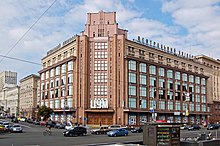
As with most
Official figures show that between 2004 and 2008 Kyiv's economy outstripped the rest of the country's, growing by an annual average of 11.5%.
Because the city has a large and diverse economic base and is not dependent on any single industry or company, its unemployment rate has historically been relatively low – only 3.75% over 2005–2008.[122] Indeed, even as the rate of joblessness jumped to 7.1% in 2009, it remained far below the national average of 9.6%.[122][123]
As of January 2022, the average monthly salary in Kyiv reached 21,347 UAH (€540) gross and 17,184 UAH (€430) net.[124][125][126]
Kyiv is the undisputed center of business and commerce of Ukraine and home to the country's largest companies, such as
In May 2011, Kyiv authorities presented a 15-year development strategy which calls for attracting as much as EUR82 billion of foreign investment by 2025 to modernize the city's transport and utilities infrastructure and make it more attractive for tourists.[132]
| 2004 | 2005 | 2006 | 2007 | 2008 | 2009 | 2010 | 2011 | 2012 | 2013 | |
|---|---|---|---|---|---|---|---|---|---|---|
bn)[120] |
61.4 | 77.1 | 95.3 | 135.9 | 169.6 | 169.5 | 196.6 | 223.8 | 275.7 | |
| Nominal GRP (USD bn)**[120][133] | 11.5 | 15.0 | 18.9 | 26.9 | 32.2 | 21.8 | 24.8 | 28.0 | 34.5 | |
| Nominal GRP per capita (USD)**[120][133] | 4,348 | 5,616 | 6,972 | 9,860 | 11,693 | 7,841 | 8,875 | 10,007 | 12,192 | 13,687 |
| Monthly wage (USD)**[133][134] | 182 | 259 | 342 | 455 | 584 | 406 | 432 | 504 | 577 | |
Unemployment rate (%)***[135] |
n/a | 4.6 | 3.8 | 3.3 | 3.3 | 7.1 | 6.4 | 6.1 | 6.0 | 5.7 |
| Retail sales (UAH bn)[127] | n/a | n/a | n/a | 34.87 | 46.50 | 42.79 | 50.09 | 62.80 | 73.00 | 77.14 |
| Retail sales (USD bn)[127][133] | n/a | n/a | n/a | 6.90 | 8.83 | 5.49 | 6.31 | 7.88 | 9.14 | 9.65 |
| Foreign direct investment (USD bn)[136] | 2.1 | 3.0 | 4.8 | 7.0 | 11.7 | 16.8 | 19.2 | 21.8 | 24.9 | 27.3 |
* – data not available; ** – calculated at annual average official exchange rate; *** – ILO methodology (% of workforce).
Industry
Primary
Manufacture
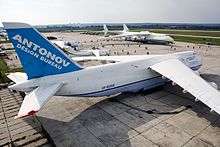
- Kuznia na Rybalskomu, naval production
- Antonov Serial Production Plant (former Aviant), airplanes manufacturing
- Aeros, small aircraft production
- Kyiv Roshen Factory, confectionery
- Kyiv Arsenal (former arms manufacturer), specializes in production of optic-precision instruments
- Obolon, brewery
- Kyiv Aircraft Repair Plant 410, repair factory at Zhuliany Airport
Education and science
Scientific research
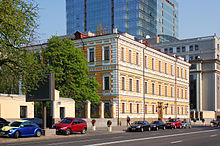
Scientific research is conducted in many institutes of higher education and, additionally, in many research institutes affiliated with the Ukrainian Academy of Sciences. Kyiv is home to Ukraine's ministry of education and science, and is also noted for its contributions to medical and computer science research.
In 2016, UNIT Factory (Ukrainian National IT Factory) opened. It offers a completely new format of IT education. The education is completely free for all trainees subject to compliance with the terms of the program. Within this project are the Technology Companies' Development Center (TCDC), BIONIC University open inter-corporate IT-university, as well as two hi-tech laboratories—VR Lab (Crytek) and Smart City lab.[138]
University education

Kyiv hosts many universities, the major ones being Kyiv National Taras Shevchenko University,[139] the National Technical University "Kyiv Polytechnic Institute",[140] Kyiv-Mohyla Academy[141] and the Kyiv National University of Trade and Economics. Of these, the Mohyla Academy is the oldest, founded as a theological school in 1632, but Shevchenko University, founded in 1834, is the oldest in continuous operation. The total number of institutions of higher education in Kyiv approaches 200,[142] allowing young people to pursue almost any line of study. While education traditionally remains largely in the hands of the state there are several accredited private institutions in the city.
Secondary education
There are about 530 general secondary schools and about 680 nursery schools and kindergartens in Kyiv.[143] Additionally, there are evening schools for adults, specialist technical schools, and the Evangel Theological Seminary.
Public libraries
There are many libraries in the city, with the
Infrastructure
Transportation
Local public transport
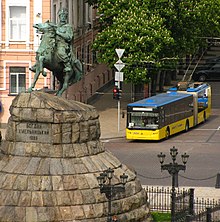
Local public transportation in Kyiv includes the Metro, buses and
The publicly owned and operated Kyiv Metro is the fastest, the most convenient and affordable network that covers most, but not all, of the city. The Metro is expanding towards the city limits to meet growing demand, having three lines with a total length of 66.1 kilometres (41.1 miles) and 51 stations (some of which are renowned architectural landmarks). The Metro carries around 1.422 million passengers daily[146] accounting for 38% of the Kyiv's public transport load. In 2011, the total number of trips exceeded 519 million.[citation needed]
The historic tram system was the first electric tramway in the former Russian Empire and the third one in Europe after the Berlin Straßembahn and the Budapest tramway. The tram system consists of 139.9 km (86.9 mi) of track,[147] including 14 km (8.7 mi) two Rapid Tram lines, served by 21 routes with the use of 523 tram cars. Once a well maintained and widely used method of transport, the system is now gradually being phased out in favor of buses and trolleybuses.
The Kyiv Funicular was constructed during 1902–1905. It connects the historic Uppertown, and the lower commercial neighborhood of Podil through the steep Saint Volodymyr Hill overseeing the Dnieper River. The line consists of two stations.
All public road transport (except for some minibuses) is operated by the united Kyivpastrans municipal company. It is heavily subsidized by the city.
The Kyiv public transport system, except for taxi, uses a simple flat rate tariff system regardless of distance traveled: tickets or tokens must be purchased each time a vehicle is boarded. Digital ticket system is already established in Kyiv Metro, with plans for other transport modes. The cost of one ride is far lower than in Western Europe.
The taxi market in Kyiv is expansive but not regulated. In particular, the taxi fare per kilometer is not regulated. There is a fierce competition between private taxi companies.[citation needed]

Roads and bridges
Kyiv represents the focal point of Ukraine's "national roads" system, thus linked by road to all cities of the country. European routes ![]() ,
, ![]() and
and ![]() intersect in Kyiv.
intersect in Kyiv.
There are eight Dnieper bridges and dozens of grade-separated intersections in the city. Several new intersections are under construction. There are plans to build a full-size, fully grade-separated ring road around Kyiv.[148][149][150]
In 2009, Kyiv's roads were in poor technical condition and maintained inadequately.[151]
Traffic jams and lack of parking space are growing problems for all road transport services in Kyiv.
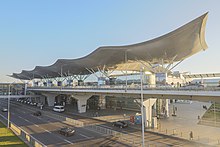
Air transport
Kyiv is served by two international passenger airports: the
Railways

Railways are Kyiv's main mode of intracity- and suburban transportation. The city has a developed railroad infrastructure including a long-distance passenger station, 6 cargo stations, depots, and repairing facilities. However, this system still fails to meet the demand for passenger service. Particularly, the Kyiv-Pasazhyrskyi railway station is the city's only long-distance passenger terminal (vokzal).
Construction is underway for turning the large Darnytsia railway station on the left-bank part of Kyiv into a long-distance passenger hub, which may ease traffic at the central station.[152] Bridges over the Dnieper River are another problem restricting the development of city's railway system. Presently, only one rail bridge out of two is available for intense train traffic. A new combined rail-auto bridge is under construction, as a part of Darnytsia project.
In 2011, the Kyiv city administration established the new Urban Train for Kyiv. This service runs at standard 4- to 10-minute intervals throughout the day and follows a circular route around the city centre, which allows it to serve many of Kyiv's inner suburbs. Interchanges between the Kyiv Metro and Fast Tram exist at many of the urban train's station stops.[153]
Suburban 'Kyiv City Express' trains (colloquially known as elektrychka) are serviced by the publicly owned Ukrainian Railways. The suburban train service is fast, and unbeatably safe in terms of traffic accidents. But the trains are not reliable, as they may fall significantly behind schedule, may not be safe in terms of crime, and the elektrychka cars are poorly maintained and overcrowded in rush hours.
There are nine elektrychka directions from Kyiv:[154]
- Bila Tserkva – Uzyn
- Fastiv
- Klavdiievo
- Myronivka – Bohuslav
- Nizhyn
- Ukrainka
- Vasylkiv
- Vyshhorod
- Yahotyn
More than a dozen of elektrychka stops are within the city allowing residents of different neighborhoods to use the suburban trains.
Energy
DTEK Kyiv Electric Networks (formerly Kyivenergo) is the electric power distribution network operator for Kyiv, owned by oligarch Rinat Akhmetov. As of 2021[update] it had:[155]
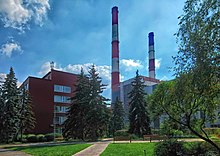
- 12,038 km of power transmission lines with a voltage of 0.4–110 kV
- 64 substations with a voltage of 35–110 kV
- 243 transformer substationsat 10 kV
In line with the EU Third Energy Package, since 2019 state energy policy abandoned the Rotterdam plus system and has required transmission system operator (TSO) and regional utilities unbundling in order to separate electricity distribution and retail electricity supply.[156]
Water and sanitation
The national government has delegated responsibility for water and sanitation services to local authorities.[157] Kyivvodokanal is a private joint-stock company that provides such services to Kyiv. The length of water supply networks is 4231 km, of which 1798 km are dilapidated. The length of sewage networks is 2662 km, of which 830 km are dilapidated.
Twin towns – sister cities
 Ankara, Turkey (1993)
Ankara, Turkey (1993) Ashgabat, Turkmenistan (2001)
Ashgabat, Turkmenistan (2001) Astana, Kazakhstan (1998)
Astana, Kazakhstan (1998) Athens, Greece (1996)
Athens, Greece (1996) Baku, Azerbaijan (1997)
Baku, Azerbaijan (1997) Beijing, China (1993)
Beijing, China (1993) Berlin, Germany (2023)[159]
Berlin, Germany (2023)[159] Bishkek, Kyrgyzstan (1997)
Bishkek, Kyrgyzstan (1997) Brasília, Brazil (2000)
Brasília, Brazil (2000) Bratislava, Slovakia (1969)
Bratislava, Slovakia (1969) Brussels, Belgium (1997)
Brussels, Belgium (1997) Bucharest, Romania (2022)[160]
Bucharest, Romania (2022)[160] Buenos Aires, Argentina (2000)
Buenos Aires, Argentina (2000) Chicago, United States (1991)
Chicago, United States (1991) Chișinău, Moldova (1993)
Chișinău, Moldova (1993) Copenhagen, Denmark (2023)[161]
Copenhagen, Denmark (2023)[161] Edinburgh, Scotland (1989)
Edinburgh, Scotland (1989) Florence, Italy (1967)
Florence, Italy (1967) Jakarta, Indonesia (2005)
Jakarta, Indonesia (2005) Kraków, Poland (1993)
Kraków, Poland (1993) Kyoto, Japan (1971)
Kyoto, Japan (1971) Leipzig, Germany (1956)
Leipzig, Germany (1956) Lima, Peru (2005)
Lima, Peru (2005) Mexico City, Mexico (1997)
Mexico City, Mexico (1997) Munich, Germany (1989)
Munich, Germany (1989) Odense, Denmark (1989)
Odense, Denmark (1989) Osh Region, Kyrgyzstan (2002)
Osh Region, Kyrgyzstan (2002) Pretoria, South Africa (1993)
Pretoria, South Africa (1993) Riga, Latvia (1998)
Riga, Latvia (1998) Rio de Janeiro, Brazil (2000)
Rio de Janeiro, Brazil (2000) Santiago, Chile (1998)
Santiago, Chile (1998) Sofia, Bulgaria (1997)
Sofia, Bulgaria (1997) Suzhou, China (2005)
Suzhou, China (2005) Tallinn, Estonia (1994)
Tallinn, Estonia (1994) Tampere, Finland (1954)
Tampere, Finland (1954) Tashkent, Uzbekistan (1998)
Tashkent, Uzbekistan (1998) Tbilisi, Georgia (1999)
Tbilisi, Georgia (1999) Toulouse, France (1975)
Toulouse, France (1975) Vilnius, Lithuania (1991)
Vilnius, Lithuania (1991) Warsaw, Poland (1994)
Warsaw, Poland (1994) Wuhan, China (1990)
Wuhan, China (1990)
Other cooperation agreements
Notable people
Arts, literature, and entertainment
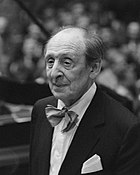

- Leonid Bronevoy (1928–2017), Soviet and Russian actor
- Mikhail Bulgakov (1891–1940), Soviet writer, medical doctor and playwright
- Eugenia Chuprina (born 1971), poet, novelist, writer and playwright
- Daniel the Traveller, 12th-century travel writer from the Kievan Rus'[162]
- Ilya Ehrenburg (1891–1967), Soviet writer, journalist, translator and cultural figure
- Eastern Roman Empireand the Bulgarian Empire
- Dmytro Hnatyuk (1925–2016), Soviet and Ukrainian opera singer
- Olha Haidamaka (born 1990), Ukrainian artist
- Milton Horn (1906–1995), Russian-American sculptor
- Vladimir Horowitz (1903–1989), American classical pianist
- Viktor Ivanov (1909–1981), Soviet film director
- Milla Jovovich (born 1975), American actress
- Sonya Koshkina (born 1985), Ukrainian journalist, editor-in-chief
- Kateryna Kukhar (born 1982), prima ballerina
- Danylo Knyshuk (born 1978), Ukrainian sculptor
- Viacheslav Kryshtofovych (born 1947), Ukrainian film director and actor
- Ana Layevska (born 1982), Ukrainian-Mexican actress
- Boris Levit-Broun (born 1950), Russian poet, writer, and artist
- Serge Lifar (1905–1986), French ballet dancer
- geometric abstract art and the originator of the avant-garde Suprematist movement
- Natalya Marchenkova (born 1948), animator and animation director, born in Kyiv[163]
- Natalia Matsak (born 1982), ballet dancer
- Galyna Moskvitina (born 1963), painter
- Ivan Putrov (born 1980), dancer, former Principal with The Royal Ballet in London
- Maksym Petrenko (1983–2022), Ukrainian writer, scientist, inventor, educator, soldier
- Yudif Grigorevna Rozhavskaya (1923–1982), composer and pianist
- Yuriy Rybchynskyi (born 1945), poet and playwright
- Natalya Semenchenko (born 1976), professor, writer, and publicist
- Lev Shestov (1866–1938), Russian existentialist philosopher
- Oksana Shvets (1955–2022), Ukrainian actress
- Alexander Vertinsky (1889—1957), singer, composer, poet, cabaret artist and actor
- Ludmila Anatolievna Yaroshevskaya (1906–1975), composer
- Artemy Vedel (1767–1808), composer
Science and technology
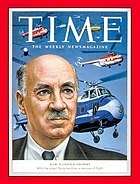
- Nikolai Amosov (1913–2002), Soviet and Ukrainian heart surgeon and inventor
- Zino Davidoff (1906–1994), Swiss premium tobacco manufacturer; known as "King of Cigars"
- Jan Koum (born 1976), American computer programmer, CEO and co-founder of WhatsApp
- Viktor Kaspruk, (born 1955), political scientist
- Alexander Ostrowski (1893–1986), mathematician
- Borys Paton (1918–2020), scientist, chairman of the National Academy of Sciences of Ukraine
- Igor Sikorsky (1889–1972), Russian-American aviation pioneer
Politics

- Golda Meir (1898–1978), Israeli politician, the fourth Prime Minister of Israel
- Henry P. Melnikow, economic consultant to unions involved in labor
Religion
- Nikolai Berdyaev (1874–1948), Russian Orthodox religious and political philosopher
- Jonathan Markovitch (born 1967), Chief Rabbi of Kyiv
- Petro Mohyla (1596–1647), Metropolitan bishop of Kyiv from 1633[164]
- Mikhail Morgulis (1941–2021), Russian-language writer, editor and theologian
- Moses of Kiev, 12th century Talmudist
- Theophan Prokopovich (1681–1736), theologian, poet, mathematician and philosopher[165]
Military conflicts
- Eugeniusz Horbaczewski (1917–1944), Polish fighter pilot
- Yuliia "Taira" Paievska (born 1968), founder of "Taira's Angels"
Sport
- Oleg Blokhin (born 1952), Ukrainian football player
- Oleg Ladik (born 1971), Ukrainian-born Canadian Olympic wrestler
- Valeriy Lobanovskyi (1939–2002), Soviet and Ukrainian football coach
- Oleksandr Saliuk Jr. (born 1978), Ukrainian rally driver
- Andriy Shevchenko (born 1976), Ukrainian footballer
- Igor Slyusar (born 1989), Ukrainian professional ice hockey player
- Igor Skuz (born 1976), Ukrainian racing driver
Other
- Rurikid prince who ruled 882–912[166]
- Olga of Kiev (c. 900–969), a regent of Kievan Rus' for her son Sviatoslav from 945 until 960[167]
- Nicholas Pritzker, scion of the Pritzker Family
- Vladimir the Great (c. 958–1015), Grand Prince of Kiev and ruler of Kievan Rus' from 980 to 1015[168]
- Israel Markovich Brodsky(1823–1888), businessman and philanthropist
Honour
- Kyiv Peninsula in Graham Land, Antarctica, is named after the city of Kyiv.[169]
See also
- List of national landmarks of cultural heritage in Kyiv
- List of crossings of the Dnieper River
- List of universities, colleges, and research institutions in Kyiv
- Outline of Ukraine
- Yehupetz
Notes
- ^ See § Name for alternative spellings and pronunciations.
- ^ pre-1918 spelling: Кіевъ
- ^ pre-1918 spelling: Кій
References
- ^ a b "Kyiv – History". Encyclopædia Britannica. Archived from the original on 4 May 2015. Retrieved 9 March 2020.
- ^ a b "Number of present population of Ukraine 1 January 2022" (PDF) (in Ukrainian). UkrStat.gov.ua. 1 January 2022. Archived (PDF) from the original on 10 August 2022. Retrieved 20 February 2023.
- ^ Oksana Lyachynska (31 May 2012). "Kyiv's 1,530th birthday marked with fun, protest". Kyiv Post. Archived from the original on 1 June 2014. Retrieved 16 May 2013.
- ^ a b Vitali Klitschko sworn in as mayor of Kyiv Archived 11 November 2020 at the Wayback Machine, Interfax-Ukraine (5 June 2014)
- ^ a b Poroshenko appoints Klitschko head of Kyiv city administration – decree Archived 4 July 2014 at the Wayback Machine, Interfax-Ukraine (25 June 2014)
Poroshenko orders Klitschko to bring title of best European capital back to Kyiv Archived 14 July 2014 at the Wayback Machine, Interfax-Ukraine (25 June 2014) - ^ "Major Agglomerations of the World". Citypopulation.de. 1 January 2021. Archived from the original on 23 November 2019. Retrieved 23 September 2021.
- ^ "Definition of KYIV". Merriam-Webster.com Dictionary. Archived from the original on 28 September 2022. Retrieved 11 May 2023.
- ^ "Kyiv definition and meaning". Collins English Dictionary. Archived from the original on 28 November 2022. Retrieved 11 May 2023.
- ^ kievan. (n.d.). Dictionary.com Unabridged Archived 14 March 2013 at the Wayback Machine, retrieved 29 May 2013 from Dictionary.com
- ^ "ВАЛОВИЙ РЕГІОНАЛЬНИЙ ПРОДУКТ У 2021 РОЦІ".
- ^ "City Mayors: The 500 largest European cities (1 to 100)". www.citymayors.com. Archived from the original on 2 January 2010. Retrieved 19 February 2017.
- ^ "Kiev". TheFreeDictionary.com. Archived from the original on 5 August 2018. Retrieved 4 July 2015.
- ISBN 978-1-4426-9879-6. Archivedfrom the original on 14 June 2020. Retrieved 9 September 2017.
- ^ Preston, Rich [@RichPreston] (25 February 2022). "And here's what the BBC Pronunciation Unit advises. We changed our pronunciation and spelling of Kiev to Kyiv in 2019" (Tweet) – via Twitter.
- ^ "Kyiv". Merriam-Webster.com Dictionary. Retrieved 24 February 2022.
- ISBN 978-0-521-15255-6.
- ^ ISBN 978-1-4058-8118-0.
- ^ Trubachev, O. N., ed. (1987). "*kyjevъ/*kyjevo". Ėtimologicheskiĭ slovarʹ slavi͡anskikh I͡Azykov: Praslavi͡anskiĭ leksicheskiĭ fond (in Russian). Vol. 13 (*kroměžirъ–*kyžiti). Moscow: Nauka. pp. 256–257.
- ^ Rudnyc'kyj, Jaroslav Bohdan (1962–1982). An etymological dictionary of the Ukrainian language. 2., rev. ed. Winnipeg: Ukrainian free acad. of sciences, pp. 660–663.
- ^ a b "Kiev". Collins English Dictionary. HarperCollins. Archived from the original on 1 May 2021. Retrieved 14 November 2020. The entry is the same as the print edition of Collins Dictionary of English (13th ed.). Glasgow, UK: HarperCollins. 2018. It includes the note "Ukrainian name: Kyiv". For American English, the website also includes the definition from Webster's New World College Dictionary (4th ed.). Boston: Houghton Mifflin Harcourt. 2010. In the 2018 fifth edition, WNWCD changed the main headword to Kyiv, with Kiev as a see-also entry with the label "Russ. name for Kyiv".
- ^ "Kiev". Merriam-Webster.com Dictionary. Merriam-Webster. Archived from the original on 13 November 2020. Retrieved 14 November 2020. Merriam–Webster's online dictionary entry has the headword "Kiev" with the label "variants: or Ukrainian Kyiv or Kyyiv." According to M–W's help on entries Archived 11 August 2020 at the Wayback Machine, the key word or signals an equal variant spelling: "these the two spellings occur with equal or nearly equal frequency and can be considered equal variants. Both are standard, and either one may be used according to personal inclination."
- ^ Ukrainian Commission for Legal Terminology. "Kiev?, Kyiv?! Which is right?". UA Zone. Archived from the original on 26 May 2011. Retrieved 15 March 2011.
- ^ "Kiev". Oxford Dictionary on Lexico.com. Archived from the original on 12 November 2020. Retrieved 14 November 2020. The entry includes the usage note "Ukrainian name Kyiv", and the dictionary has a see-also entry for "Kyiv" cross-referencing this one. The entry text is republished from the print edition of the Oxford Dictionary of English (3rd ed.). Oxford University Press. 2010.
- ^ "Kiev". Longman Dictionary of Contemporary English Online. Pearson English Language Teaching. Archived from the original on 6 May 2017. Retrieved 14 November 2020.
- The Atlantic Council. 21 October 2019. Archivedfrom the original on 19 January 2020. Retrieved 26 May 2021.
- ^ a b c d Kyiv Archived 24 November 2016 at the Wayback Machine at Ukrainian Soviet Encyclopedia
- ^ Kiev Archived 24 November 2016 at the Wayback Machine in the Ukrainian Soviet Encyclopedia: "Населення періоду мідного віку на тер. К. було носієм т. з. трипільської культури; відомі й знахідки окремих предметів бронзового віку."
- ^ Encyclopædia Britannica. Retrieved 9 March 2020.
- ^ Petro Tolochko, Glib Ivakin, Yaroslava Vermenych. Kyiv Archived 26 February 2022 at the Wayback Machine. Encyclopedia of History of Ukraine.
- ^ Rabinovich GA From the history of urban settlements in the eastern Slavs. In the book.: History, culture, folklore and ethnography of the Slavic peoples. M. 1968. 134.
- ISBN 9786177765010. Archivedfrom the original on 21 June 2020. Retrieved 17 June 2020 – via Google Books.
- ^ Hazlitt, William (22 February 1851). "The Classical Gazetteer: A Dictionary of Ancient Geography, Sacred and Profane". Whittaker. Archived from the original on 4 August 2020. Retrieved 17 June 2020 – via Google Books.
- ^ Sigfús Blöndal. "The Varangians of Byzantium Archived 25 June 2020 at the Wayback Machine".
- ^ History Archived 13 June 2020 at the Wayback Machine. Pechersk Raion in the Kiev City.
- ^ dr. Viktor Padányi – Dentu-Magyaria p. 325, footnote 15
- ^ Lowe, Steven; Ryaboy, Dmitriy V. "The Pechenegs". Archived from the original on 27 October 2009. Retrieved 27 October 2009.
- ISBN 978-0-674-03873-8. Archivedfrom the original on 28 July 2014. Retrieved 13 December 2015.
- ISBN 9780521864039. Archived from the original(PDF) on 29 March 2017.
- ISBN 9780521548113.
- ^ Janet Martin, Medieval Russia:980–1584, (Cambridge University Press, 1996), 100.
- ^ The Destruction of Kiev, University of Toronto Research Repository
- ^ Orest Subtelny (1989). Ukraine. A History. [Illustr.] (Repr.). CUP Archive. p. 38. Archived from the original on 14 June 2020. Retrieved 13 December 2015.
- ISBN 978-0-521-36290-0
- ISBN 0-521-61857-6
- ^ ""Ukraina: Lietuvos epocha, 1320–1569"". Bernardinai.lt (in Lithuanian). 3 May 2010. Archived from the original on 10 August 2023. Retrieved 10 August 2023.
- ^ "Хто побудував київський замок?". Про Україну (in Ukrainian). Archived from the original on 1 January 2017. Retrieved 22 October 2023.
- ISBN 978-0-231-05351-8
- ISBN 0-295-97580-6
- ^ Т.Г. Таирова-Яковлева, Иван Выговский // Единорогъ. Материалы по военной истории Восточной Европы эпохи Средних веков и Раннего Нового времени, вып.1, М., 2009: Под влиянием польской общественности и сильного диктата Ватикана сейм в мае 1659 г. принял Гадячский договор в более чем урезанном виде. Идея Княжества Руського вообще была уничтожена, равно как и положение о сохранении союза с Москвой. Отменялась и ликвидация унии, равно как и целый ряд других позитивных статей.
- ^ Eugeniusz Romer, O wschodniej granicy Polski z przed 1772 r., w: Księga Pamiątkowa ku czci Oswalda Balzera, t. II, Lwów 1925, s. [358].
- ISBN 0-618-08231-X.
- ^ "The Great Purge under Stalin 1937–38". brama.com. Archived from the original on 24 January 2010. Retrieved 14 January 2010.
- ISBN 0805074619, pages 227–315.
- ISBN 1-4000-4005-1), 720 pages.
- ^ Daniel Goldhagen, Hitler's Willing Executioners (p. 290) – "2.8 million young, healthy Soviet POWs" killed by the Germans, "mainly by starvation... in less than eight months" of 1941–42, before "the decimation of Soviet POWs... was stopped" and the Germans "began to use them as laborers".
- ^ "Babi Yar". Jewish Virtual Library. 2012. Archived from the original on 17 August 2014. Retrieved 6 July 2014.
- ISBN 1-59228-467-1), p. 83.
- ^ "Kiev and Babi Yar". Holocaust Encyclopedia. United States Holocaust Memorial Museum. Archived from the original on 23 March 2010. Retrieved 13 March 2016.
- ^ "У Києві біля водойм відкрито 32 зони для відпочинку, з яких 12 – із можливістю купання". kyivcity.gov.ua (in Ukrainian). 19 June 2020. Archived from the original on 9 August 2020. Retrieved 12 October 2020.
- ^ "У Кличка розповіли, де в Києві можна купатися, а де тільки засмагати. Список". pravda.com.ua (in Ukrainian). 19 June 2020. Archived from the original on 24 June 2020. Retrieved 12 October 2020.
- ^ "Urban agglomerations with 750,000 inhabitants or more in 2011 and types of natural risks". United Nations, Department of Economic and Social Affairs, Population Division. April 2012. Archived from the original on 6 October 2014. Retrieved 1 September 2013.
- (PDF) from the original on 5 March 2012. Retrieved 24 August 2012.
- ^ a b c "ЦГО Кліматичні дані по м.Києву". cgo-sreznevskyi.kyiv.ua (in Ukrainian). Central Observatory for Geophysics. Archived from the original on 18 April 2020. Retrieved 12 October 2020.
- ^ a b c "ЦГО Кліматичні рекорди". cgo-sreznevskyi.kyiv.ua (in Ukrainian). Central Observatory for Geophysics. Archived from the original on 31 March 2020. Retrieved 12 October 2020.
- ^ "Weather and Climate – The Climate of Kyiv" (in Russian). Weather and Climate (Погода и климат). Archived from the original on 13 December 2019. Retrieved 8 November 2021.
- ^ "World Meteorological Organization Climate Normals for 1981–2010". World Meteorological Organization. Archived from the original on 17 July 2021. Retrieved 17 July 2021.
- ^ Cappelen, John; Jensen, Jens. "Ukraine – Kyiv" (PDF). Climate Data for Selected Stations (1931–1960) (in Danish). Danish Meteorological Institute. p. 332. Archived from the original (PDF) on 27 April 2013. Retrieved 1 April 2016.
- ^ "Kiev, Ukraine – Detailed climate information and monthly weather forecast". Weather Atlas. Yu Media Group. Archived from the original on 3 July 2019. Retrieved 3 July 2019.
- ^ Klitschko officially announced as winner of Kyiv mayor election Archived 7 September 2020 at the Wayback Machine, Interfax-Ukraine (4 June 2014)
- ^ Vitali Klitschko wins in first round of Kyiv mayor election Archived 6 November 2020 at the Wayback Machine, Ukrinform (6 November 2020)
- ISBN 5-12-004335-6, pp. 1–623, 1996.
- Ukrayinska Pravda. Archivedfrom the original on 1 May 2014. Retrieved 19 August 2013.
- ^ Свобода, Радіо (31 October 2012). "Виборчі комісії фіксують перемогу опозиційних кандидатів у Києві". Радіо Свобода. Archived from the original on 22 February 2022. Retrieved 22 February 2022.
- ^ Битва за Київ: чому посада мера вже не потрібна Кличку і чи будуть вибори взагалі (in Ukrainian). Kontrakty. 19 March 2013. Archived from the original on 24 August 2013. Retrieved 19 August 2013.
- ^ У кожного киянина в голові – досвід Майдану (in Ukrainian). 20 April 2013. Archived from the original on 5 March 2022. Retrieved 19 August 2013.
- ISBN 978-3-525-36912-8 (page 396)from the original on 25 August 2013. Retrieved 18 August 2013.
Party of Regions gets 185 seats in Ukrainian parliament, Batkivschyna 101 – CEC Archived 31 October 2013 at the Wayback Machine, Interfax-Ukraine (12 November 2012)
UDAR submits to Rada resolution on Ukraine's integration with EU, Interfax-Ukraine (8 January 2013)
(in Ukrainian) Electronic Bulletin "Your Choice – 2012". Issue 4: Batkivshchyna Archived 3 December 2013 at the Wayback Machine, Ukrainian Center for Independent Political Research (24 October 2012)
Ukraine's Party System in Transition? The Rise of the Radically Right-Wing All-Ukrainian Association "Svoboda" Archived 2 February 2014 at the Wayback Machine by Andreas Umland, Centre for Geopolitical Studies (1 May 2011)
"Вибори-2012. Результати голосування" (in Ukrainian). Archived - ^ How relations between Ukraine and Russia should look like? Public opinion polls' results Archived 23 December 2017 at the Wayback Machine, Kyiv International Institute of Sociology (4 March 2014)
- ^ (in Ukrainian) Elections to Kyiv district councils will take place on October 30 [2022] – the decision of the Kyiv City Council Archived 3 February 2022 at the Wayback Machine, Interfax-Ukraine (3 February 2022)
- ^ Чисельність населення м.Києва [Population of Kyiv city] (in Ukrainian). UkrStat.gov.ua. 1 November 2015. Archived from the original on 9 October 2020. Retrieved 9 January 2016.
- ISBN 978-966-8459-28-3.
- ^ Kudritskiy, A. V. (1982). KIEV entsiklopedicheskiy spravochnik. Kiev: Glavnaya redaktsia Ukrainskoy Sovetskoy Entsiklopedii. p. 30.
- Ukrainian census, conducted on 5 December 2001, gave the population of Kyiv as 2 611 300 (Ukrcensus.gov.ua – Kyiv city Web address accessed on 4 August 2007). Estimates based on the amount of bakery products sold in the city (thus including temporary visitors and commuters) suggest a minimum of 3.5 million. "There are up to 1.5 mln undercounted residents in Kiev Archived 2 December 2008 at the Wayback Machine", Korrespondent, 15 June 2005 (in Russian)
- ^ "There are up to 1.5 mln undercounted residents in Kiev". Korrespondent (in Russian). 15 June 2007. Archived from the original on 2 December 2008. Retrieved 2 September 2013.
- ^ Hamm 1993, p. 103.
- ^ Hamm 1993, p. 103-104.
- ISBN 978-1-4426-4098-6. Archived from the original on 25 April 2023. Retrieved 29 March 2023 – via Google Books.
- ^ Kubijovyč, Volodymyr; Pavlovsky, Vadym; Stebelsky, Ihor; Zhukovsky, Arkadii (2017). "Kyiv". Encyclopedia of Ukraine. Archived from the original on 24 March 2023. Retrieved 29 March 2023.
- ^ Kubijovyč, Volodymyr; Pavlovsky, Vadym; Stebelsky, Ihor; Zhukovsky, Arkadii. "Kyiv". Encyclopedia of Ukraine. Archived from the original on 24 March 2023. Retrieved 29 March 2023.
- ^ a b "Ukrainian Municipal Survey, March 2–20 2015" (PDF). IRI. Archived (PDF) from the original on 19 October 2017. Retrieved 27 May 2015.
- 2001 census data: "Всеукраїнський перепис населення 2001 | Результати | Основні підсумки | Національний склад населення | місто Киів" (in Ukrainian). ukrcensus.gov.ua. Archived from the originalon 14 December 2009. Retrieved 14 January 2010. "Всеукраїнський перепис населення 2001 | Результати | Основні підсумки | Мовний склад населення | місто Київ" (in Ukrainian). ukrcensus.gov.ua. Archived from the original on 25 January 2010. Retrieved 14 January 2010.
- Zerkalo Nedeli, 29 April – 12 May 2006. in Russian. Archived 17 February 2007 at the Wayback Machine, in Ukrainian Archived 17 February 2007 at the Wayback Machine
- ^ "What language is spoken in Ukraine?". Welcome to Ukraine. Archived from the original on 11 October 2017. Retrieved 12 February 2016.
- ^ Первая всеобщая перепись населения Российской Империи 1897 г. Распределение населения по родному языку и уездам. г. Киев Archived 3 March 2016 at the Wayback Machine (in Russian).
- ^ a b "Kiev". www.jewishvirtuallibrary.org. Archived from the original on 18 August 2016. Retrieved 24 May 2019.
- ^ "The Jewish Community of Kiev". The Museum of the Jewish People at Beit Hatfutsot. Archived from the original on 13 June 2020. Retrieved 1 August 2019.
- ^ "Kiev and Babi Yar". Holocaust Encyclopedia. United States Holocaust Memorial Museum. Archived from the original on 3 January 2007.
- ^ Gutman, Israel (1990). Encyclopedia of the Holocaust, vol. 1. Macmillan. pp. 133–6.
- ^ "State-sponsored Anti-Semitism in Postwar USSR. Studies and Research Perspectives; Antonella Salomoni". Quest. Issues in Contemporary Jewish History / Questioni di storia ebraica contemporanea. 2 April 2010. Archived from the original on 22 January 2020. Retrieved 26 July 2012.
- ^ alla levy. "Jewish People Around the World". Archived from the original on 31 August 2013. Retrieved 4 July 2015.
- ^ a b c d e Forgotten Soviet Plans For Kyiv Archived 4 February 2012 at the Wayback Machine, Kyiv Post (28 July 2011)
- ^ Workpermit.com Archived 30 December 2009 at the Wayback Machine. Retrieved 30 July 2006.
- ^ Kiev.info Archived 27 June 2009 at the Wayback Machine. Retrieved 20 June 2006.
- ^ Kyiv found among greenest cities in Europe, Emirates News Agency (10 December 2009)
- ^ Goukassian, Elena (15 September 2023). "Unesco adds sites in Kyiv and Lviv to list of world heritage in danger". The Art Newspaper. Archived from the original on 19 October 2023. Retrieved 14 October 2023.
- ^ Anwer, Baraa (15 September 2023). "UNESCO puts 2 locations in war-ravaged Ukraine on its list of historic sites in danger". Associated Press News. Archived from the original on 19 October 2023. Retrieved 14 October 2023.
- ^ "World Heritage in Danger". UNESCO World Heritage Convention. Archived from the original on 5 July 2020. Retrieved 14 October 2023.
- ^ a b The Ukraine Archived 3 July 2021 at the Wayback Machine, Life, 28 October 1946
- ^ "Andreyevskiy Spusk". Hotels-Kiev.com. Optima Tours. Archived from the original on 1 September 2006. Retrieved 20 June 2006.
- ^ "Andreevsky spusk". Kyiv Guide (in Russian). Archived from the original on 12 March 2007. Retrieved 20 June 2006.
- ^ "Kiev zoo a 'concentration camp for animals'". CBC news. Associated Press. 23 March 2011. Archived from the original on 9 September 2013. Retrieved 27 April 2011.
- ^ a b "Culture and Arts" (in Ukrainian). Kyiv Statistics Office. Archived from the original on 1 December 2020. Retrieved 11 October 2020.
- ^ Trophies of Dynamo Archived 18 October 2011 at the Wayback Machine – Official website of Dynamo Kyiv
- ^ "Kyiv opens host stadium for Euro 2012 final". Kyiv Post. 9 October 2011. Archived from the original on 22 October 2011.
- ^ "Туристичні потоки". Ukrstat.gov.ua. Archived from the original on 5 August 2012. Retrieved 16 September 2011.
- ^ a b "Головне управління статистики м.Києва – Туристичні потоки". kyiv.ukrstat.gov.ua. Archived from the original on 14 October 2020. Retrieved 11 October 2020.
- ^ "Number of foreign tourists in Kyiv growing". www.unian.info. Archived from the original on 30 October 2020. Retrieved 11 October 2020.
- ^ Ukrayinska Pravda. 13 November 2014
- ^ Ukrayinska Pravda(29 May 2019) (in Ukrainian)
- ISBN 978-966-8459-28-3.
- ^ a b c d e "Gross Regional Product" (in Ukrainian). Kyiv Statistics Office. Archived from the original on 1 December 2020. Retrieved 19 November 2010.
- ^ a b "Gross Domestic Product" (in Ukrainian). State Statistics Committee. Archived from the original on 23 January 2013. Retrieved 19 November 2010.
- ^ a b "Labour Market" (in Ukrainian). Kyiv Statistics Office. Archived from the original on 14 October 2020. Retrieved 23 November 2010.
- ^ "Labour Market" (in Ukrainian). Kyiv Statistics Office. Archived from the original on 23 January 2013. Retrieved 23 November 2010.
- ^ "Калькулятор зарплаты". uteka.ua. Archived from the original on 3 March 2020. Retrieved 18 February 2018.
- ^ "Средняя зарплата в Украине [2019] ᐈ Средняя зарплата в Киеве и регионах". index.minfin.com.ua. Archived from the original on 10 February 2022.
- ^ "Convert 21,347 Ukrainian Hryvnia to Euro – UAH to EUR Exchange Rates | Xe". Archived from the original on 25 February 2022. Retrieved 25 February 2022.
- ^ a b c "Retail Sales" (in Ukrainian). Kyiv Statistics Office. Archived from the original on 1 December 2020. Retrieved 11 October 2020.
- ^ "Retail Sales" (in Ukrainian). State Statistics Committee. Archived from the original on 23 January 2013. Retrieved 22 January 2011.
- ^ "Construction Works" (in Ukrainian). Kyiv Statistics Office. Archived from the original on 13 October 2020. Retrieved 11 October 2020.
- ^ "Construction Works" (in Ukrainian). State Statistics Committee. Archived from the original on 23 January 2013. Retrieved 22 January 2011.
- ^ "Square Metre Prices in Ukraine". Global Property Guide. Archived from the original on 23 July 2011. Retrieved 2 June 2011.
- ^ Santarovich, Andrey (27 May 2011). "Kyiv Development Strategy Calls for EUR82 billion in foreign investment" (in Russian). Business Information Network. Archived from the original on 19 March 2012. Retrieved 28 May 2011.
- ^ a b c d "Statistical Bulletin (May 2012)" (PDF) (in Ukrainian). National Bank of Ukraine. Archived (PDF) from the original on 8 July 2012. Retrieved 3 July 2012.
- ^ "Average Monthly Wage Dynamics" (in Ukrainian). Kyiv Statistics Office. Archived from the original on 1 December 2020. Retrieved 1 October 2020.
- ^ "Labour Market Indicators" (in Ukrainian). Kyiv Statistics Office. Archived from the original on 14 October 2020. Retrieved 1 October 2020.
- ^ "Foreign Direct Investment" (in Ukrainian). Kyiv Statistics Office. Archived from the original on 1 December 2020. Retrieved 11 October 2020.
- ^ "Industrial Production by Economic Activity" (in Ukrainian). Kyiv Statistics Office. Archived from the original on 14 October 2020. Retrieved 11 October 2020.
- ^ "UNIT Factory, a key element of the future innovation park, opened in Kyiv". kfund.ua. 16 November 2016. Archived from the original on 3 August 2019. Retrieved 18 November 2019.
- ^ See also: Kyiv University official website Archived 10 September 2017 at the Wayback Machine. Retrieved 28 July 2006.
- ^ See also: KPI official website Archived 13 May 2019 at the Wayback Machine
- ^ "National University of Kyiv-Mohyla Academy". Archived from the original on 1 February 2021. Retrieved 25 February 2022.
- ^ See also: Osvita.org URL accessed on 20 June 2006 Archived 30 January 2009 at the Wayback Machine
- ISBN 978-966-8459-28-3.
- ^ "The Vernadsky National Library of Ukraine". Nbuv.gov.ua. Archived from the original on 30 March 2010. Retrieved 27 June 2010.
- ^ "Collection of Jewish Musical Folklore (1912–1947)". UNESCO Memory of the World Programme. 16 May 2008. Archived from the original on 23 June 2008. Retrieved 14 December 2009.
- ^ "Головне управління статистики м.Києва – Пасажирські перевезення АРХІВ 2011 року". kyiv.ukrstat.gov.ua. Archived from the original on 1 December 2020. Retrieved 11 October 2020.
- ^ For a 2004 plan of the Kyiv tram, please see mashke.org Archived 3 March 2016 at the Wayback Machine
- ^ "Азаров дал добро на строительство кольцевой дороги вокруг Киева – Газета "ФАКТЫ и комментарии"". Fakty.ua. Archived from the original on 19 October 2017. Retrieved 12 March 2013.
- ^ "Вторая кольцевая дорога вокруг Киева обойдется в $5-5,5 млрд. – Последние новости Киева – Однако в направлении окружной дороги уже вся земля выкуплена | СЕГОДНЯ". Segodnya.ua. 27 June 2007. Archived from the original on 5 October 2020. Retrieved 12 March 2013.
- ^ "Азаров прогнозирует начало строительства второй кольцевой дороги вокруг Киева в 2012 году | Новости Киева". Korrespondent.net. Archived from the original on 19 October 2017. Retrieved 12 March 2013.
- ^ Kyiv Administration: Roads Are In Poor Technical State Because They Have Reached End Of Their Service Lives And Annual Maintenance Volume Is Low Archived 16 June 2009 at the Wayback Machine, Ukrainian News Agency (12 June 2009)
- ^ (in Russian) Archunion.com.ua Archived 6 February 2007 at the Wayback Machine. Retrieved 20 June 2006.
- ^ "Азаров запустил в Киеве городскую электричку | Экономика | РИА Новости – Украина". Ua.rian.ru. 13 August 2012. Archived from the original on 25 April 2012. Retrieved 12 March 2013.
- ^ "Мапа сполучень". Kyiv City Express (in Ukrainian). Archived from the original on 4 June 2023. Retrieved 21 November 2023.
- ^ "Наша компанія ДТЕК Київські електромереж". Archived from the original on 3 March 2021. Retrieved 12 August 2021.
- ^ "Ukraine electricity generation: Investment opportunities". South Korean Ministry of Foreign Affairs. 2018. Archived from the original on 14 March 2023. Retrieved 14 March 2023.
- The World Bank. "SOS DANUBIS.org – Ukraine". International Association of Water Supply Companies in the Danube River Catchment Area. Archivedfrom the original on 20 February 2023. Retrieved 20 February 2023.
- ^ "Перелік міст, з якими Києвом підписані документи про поріднення, дружбу, співробітництво, партнерство" (PDF). kyivcity.gov.ua (in Ukrainian). Kyiv. 15 February 2018. Archived (PDF) from the original on 26 August 2021. Retrieved 11 October 2020.
- ^ "Neue Städtepartnerschaft mit Kyiv: Vitali Klitschko in Berlin". berlin.de (in German). 11 September 2023. Archived from the original on 2 October 2023. Retrieved 20 September 2023.
- ^ "Nicuşor Dan: Am hotărât să aprobăm înfrăţirea dintre Bucureşti şi Kiev". mediafax.ro (in Romanian). Mediafax. 7 March 2022. Archived from the original on 5 March 2023. Retrieved 11 July 2022.
- ^ Journalist, Magnus Ankerstjerne. "København vedtager venskabsaftale med Kyiv". TV 2 Kosmopol (in Danish). Archived from the original on 29 March 2023. Retrieved 29 March 2023.
- Beazley, Charles Raymond (1911). . Encyclopædia Britannica. Vol. 7 (11th ed.). p. 808.
- ^ "Marchenkova, Natalya". animator.ru. Archived from the original on 12 June 2021. Retrieved 1 March 2021.
- ^ . Encyclopædia Britannica. Vol. 18 (11th ed.). 1911. p. 646.
- ^ Bain, Robert Nisbet (1911). . Encyclopædia Britannica. Vol. 22 (11th ed.). p. 434.
- ^ Bain, Robert Nisbet (1911). . Encyclopædia Britannica. Vol. 20 (11th ed.). pp. 76–77.
- ^ . Encyclopædia Britannica. Vol. 20 (11th ed.). 1911. p. 80.
- ^ Bain, Robert Nisbet (1911). . Encyclopædia Britannica. Vol. 28 (11th ed.). p. 168.
- ^ Kyiv Peninsula. Archived 10 July 2021 at the Wayback Machine SCAR Composite Gazetteer of Antarctica.
Further reading
- Brutzkus, J. "The Khazar Origin of Ancient Kiev". Slavonic and East European Review. American Series, vol. 3, no. 1, 1944, pp. 108–124. JSTOR. Accessed 16 June 2020.
- Chisholm, Hugh, ed. (1911). . Encyclopædia Britannica. Vol. 15 (11th ed.). Cambridge University Press. pp. 788–789.
- Hamm, Michael F. (1993). Kiev. A portrait, 1800–1917.
- Kropotkin, Peter Alexeivitch; Bealby, John Thomas (1911). . In Chisholm, Hugh (ed.). Encyclopædia Britannica. Vol. 15 (11th ed.). Cambridge University Press. pp. 789–790.
External links
- Київська міська державна адміністрація – official web portal of the Kyiv City State Administration (in Ukrainian)
- Kyiv on Twitter
- Kyiv—Official Tourist Guide

